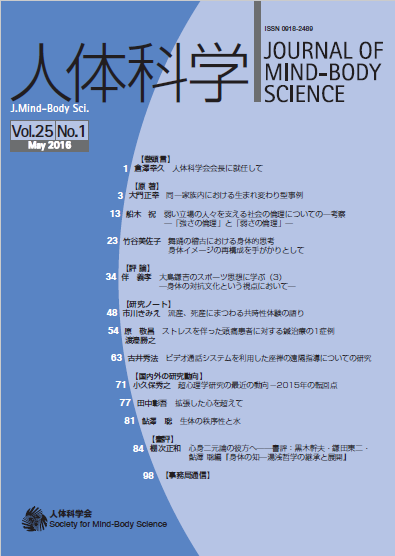Volume 25, Issue 1
Journal of Mind-Body Science
Displaying 1-19 of 19 articles from this issue
- |<
- <
- 1
- >
- >|
Contents
-
Article type: Contents
2016Volume 25Issue 1 Pages 0-
Published: 2016
Released on J-STAGE: March 01, 2018
Download PDF (875K)
Preface
-
Article type: Article
2016Volume 25Issue 1 Pages 1-2
Published: 2016
Released on J-STAGE: March 01, 2018
Download PDF (988K)
Origianl Research Papers
-
Article type: Article
2016Volume 25Issue 1 Pages 3-12
Published: 2016
Released on J-STAGE: March 01, 2018
Download PDF (1813K) -
Article type: Article
2016Volume 25Issue 1 Pages 13-22
Published: 2016
Released on J-STAGE: March 01, 2018
Download PDF (1127K) -
Article type: Article
2016Volume 25Issue 1 Pages 23-33
Published: 2016
Released on J-STAGE: March 01, 2018
Download PDF (1112K)
Commentary
-
Article type: Article
2016Volume 25Issue 1 Pages 34-47
Published: 2016
Released on J-STAGE: March 01, 2018
Download PDF (1137K)
Research Notes
-
Article type: Article
2016Volume 25Issue 1 Pages 48-53
Published: 2016
Released on J-STAGE: March 01, 2018
Download PDF (1252K) -
Article type: Article
2016Volume 25Issue 1 Pages 54-62
Published: 2016
Released on J-STAGE: March 01, 2018
Download PDF (2125K) -
Article type: Article
2016Volume 25Issue 1 Pages 63-70
Published: 2016
Released on J-STAGE: March 01, 2018
Download PDF (2176K)
Research Trends: Domestic and Foreign
-
Article type: Article
2016Volume 25Issue 1 Pages 71-76
Published: 2016
Released on J-STAGE: March 01, 2018
Download PDF (1734K) -
Article type: Article
2016Volume 25Issue 1 Pages 77-80
Published: 2016
Released on J-STAGE: March 01, 2018
Download PDF (1055K) -
Article type: Article
2016Volume 25Issue 1 Pages 81-83
Published: 2016
Released on J-STAGE: March 01, 2018
Download PDF (1032K)
Book Review
-
Article type: Article
2016Volume 25Issue 1 Pages 84-88
Published: 2016
Released on J-STAGE: March 01, 2018
Download PDF (1040K)
Reports of the Society
-
Article type: Article
2016Volume 25Issue 1 Pages 89-97
Published: 2016
Released on J-STAGE: March 01, 2018
Download PDF (1410K)
Information of the Society
-
Article type: Appendix
2016Volume 25Issue 1 Pages 98-112
Published: 2016
Released on J-STAGE: March 01, 2018
Download PDF (1146K)
Information for Authors
-
Article type: Appendix
2016Volume 25Issue 1 Pages 113-115
Published: 2016
Released on J-STAGE: March 01, 2018
Download PDF (988K)
Editor's Note
-
Article type: Appendix
2016Volume 25Issue 1 Pages 116
Published: 2016
Released on J-STAGE: March 01, 2018
Download PDF (984K) -
Article type: Appendix
2016Volume 25Issue 1 Pages 117
Published: 2016
Released on J-STAGE: March 01, 2018
Download PDF (991K)
Copyright
-
Article type: Appendix
2016Volume 25Issue 1 Pages 118-
Published: 2016
Released on J-STAGE: March 01, 2018
Download PDF (982K)
- |<
- <
- 1
- >
- >|
